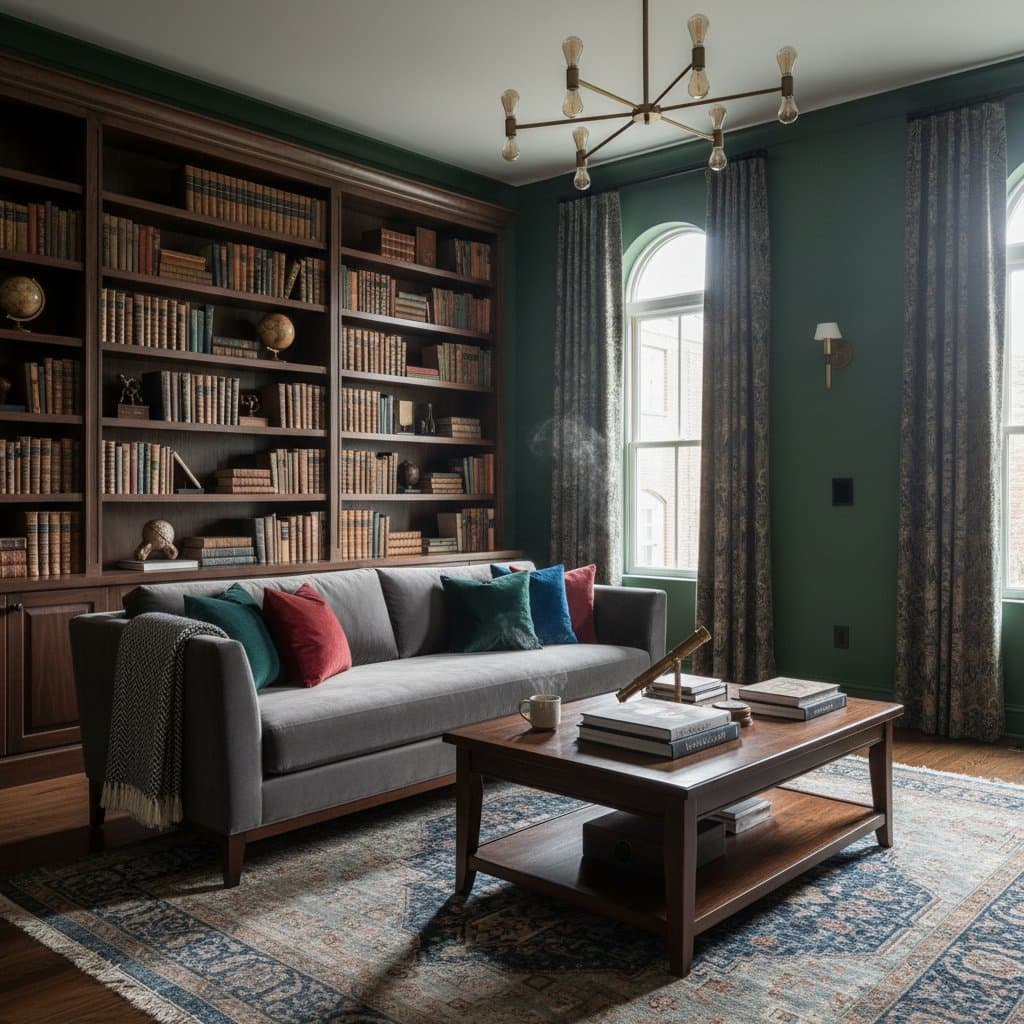Why Dark Interiors Are Accelerating Home Sales in 2025
Homebuyers in 2025 seek depth and sophistication over stark minimalism. Real estate data reveals that properties with dark, moody interiors sell 15% faster than those with lighter palettes. This trend stems from a shift toward cozy, personalized spaces that evoke luxury and tranquility, appealing to buyers weary of cookie-cutter designs.
Dark tones mask everyday wear, enhance architectural details, and create an inviting atmosphere in photographs. Listings featuring deep colors receive more inquiries and competitive bids, as they project a sense of established elegance. To capitalize on this, homeowners prepare by selecting hues that harmonize with natural light and furnishings.
Essential Lighting Strategies for Dark Spaces
Lighting elevates dark interiors from dramatic to desirable. Without proper illumination, deep colors can feel oppressive; with it, they become a selling point. Focus on three core types to ensure balance and appeal.
- Ambient lighting provides overall illumination through overhead fixtures or recessed cans, preventing shadows from overwhelming the room.
- Task lighting targets specific zones, such as desk lamps for home offices or under-cabinet fixtures in kitchens, supporting functionality without harsh glare.
- Accent lighting draws attention to features like artwork or textures via wall sconces or LED strips, adding layers of interest.
Invest in adjustable fixtures and warm bulbs rated at 2700K to 3000K for a welcoming glow. This setup not only flatters dark walls but also highlights selling features during showings.
Selecting and Pairing Dark Colors
Choosing the right dark shade requires attention to undertones, light exposure, and room function. Begin by assessing your space's orientation and existing elements. Test samples extensively to confirm compatibility.
Effective color pairings include:
- Deep navy walls paired with warm white trim for sharp, modern contrast.
- Charcoal bases with brass hardware or wood accents for a timeless, earthy vibe.
- Dark green combined with taupe upholstery or linen textiles to introduce subtle softness.
Apply samples to two walls and evaluate them under morning sun, afternoon light, and evening lamps. This reveals how colors evolve, ensuring they enhance rather than dominate the space.
How to Choose the Right Dark Color
Narrow options by aligning choices with your home's style and conditions. Follow these steps for a cohesive result.
- Identify undertones: Opt for cool blues, charcoals, or slates in contemporary settings; warm olives, espressos, or aubergines suit cozier environments.
- Align with architecture: Bold blacks or graphites complement sleek modern lines, while muted navies or forest greens fit traditional moldings.
- Evaluate natural light: Select warm deep shades for dim rooms to maintain warmth; brighter spaces tolerate cooler tones.
- Test large swatches: Paint 2x2 foot sections and monitor changes across the day.
- Incorporate texture: Pair matte walls with glossy trim, woven rugs, or wood elements to add visual depth and prevent monotony.
Prioritize lighting upgrades as your primary enhancement. A thoughtfully lit dark room appears polished and purposeful, transforming potential drawbacks into strengths.
Avoiding Common Pitfalls with Dark Interiors
Dark designs falter when they overlook balance or execution details. Recognize these errors to sidestep them.
- Applying dark paint uniformly across all rooms, creating a cave-like effect without breaks.
- Selecting glossy sheens that spotlight surface imperfections.
- Installing dark hues in north-facing areas lacking supplemental light sources.
- Neglecting bulb upgrades to higher lumen outputs.
Correct these by painting trim in lighter shades, incorporating mirrors to reflect light, or adding organic textures like oak paneling or linen curtains. Such adjustments enhance livability and buyer appeal without major overhauls.
Enduring Advantages of Dark Interiors
The impact of dark interiors extends far beyond quick sales. These spaces foster relaxation by absorbing excess light and minimizing distractions, promoting better rest in bedrooms and concentration in offices.
Deep tones offer psychological benefits, cultivating a sense of calm and stability that resonates with diverse buyers. Unlike fleeting bright trends, versatile neutrals such as charcoal or midnight blue endure seasonal shifts in decor.
On a practical level, dark surfaces retain heat slightly better, providing minor comfort in cooler climates. Maintenance remains simple, with durable paints resisting scuffs while concealing minor dirt.
Steps to Implement Dark Interiors
Transition to dark interiors methodically for optimal results. Begin with assessment and proceed to execution.
- Assess your spaces: Target areas like hallways, dining rooms, or studies that benefit from added depth without overwhelming the home.
- Establish a budget: Allocate $1,000 to $2,500 for initial testing and application in one or two rooms.
- Gather samples: Purchase quart-sized cans of three promising shades and apply generous swatches.
- Optimize lighting: Replace bulbs with higher-lumen options and experiment with each color under varied conditions.
- Schedule the work: Hire a professional painter or reserve a weekend for DIY efforts.
- Stage strategically: Introduce lighter textiles and metallic details to amplify contrast and warmth.
Dark interiors represent more than aesthetics; they provide a competitive edge in the market. Executed with precision in color, lighting, and texture, they position your home as a standout choice, drawing eager buyers and expediting the sale process.








